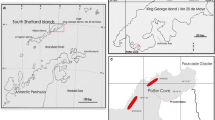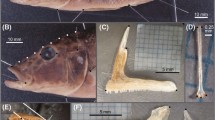Abstract
During their evolution and speciation in the Antarctic waters, notothenioid fish occupied a variety of habitats and ecological niches. The diversification led to important variations in several morphological features related to particular aspects of their ecologies. We investigated the feeding structures and biomechanics of three phylogenetically related species (family Nototheniidae) with different ecologies: the bentho-pelagic Antarctic toothfish Dissostichus mawsoni, the pelagic Antarctic silverfish Pleuragramma antarctica, and the benthic emerald rockcod Trematomus bernacchii. The suction index (SI), the mechanical advantage in jaw closing (MA), and 14 morphological traits related to their feeding activity were analyzed. Significant differences among the species were found for all the parameters considered, supporting a high level of specialization.



Similar content being viewed by others
References
Amundsen PA, Bøhn T, Våga GH (2004) Gill raker morphology and feeding ecology of two sympatric morphs of European whitefish (Coregonus lavaretus). Ann Zool Fenn 41:291–300
Balushkin AV (2000) Morphology, classification, and evolution of notothenioid fishes of the Southern Ocean (Notothenioidei, Perciformes). J Ichthyol 40(Suppl 1):S74–S109
Bansode MA, Eastman JT, Aronson RB (2014) Feeding biomechanics of five demersal Antarctic fishes. Polar Biol 37(12):1835–1848. https://doi.org/10.1007/s00300-014-1565-z
Barnett A, Bellwood DR, Hoey AS (2006) Trophic ecomorphology of cardinalfish. Mar Ecol Prog Ser 322:249–257
Bottaro M, Vacchi M (2006) Rapporto sulla Campagna Antartica Estate-Australe 2005–2006. 21° Spedizione. P.N.R.A. Programma Nazionale di Ricerche in Antartide, Progetto 2004/8.4, Final Report, Roma
Carroll AM, Wainwright PC, Huskey SH, Collar DC, Turingan RG (2004) Morphology predicts suction feeding performance in centrarchid fishes. J Exp Biol 207(22):3873–3881
Cheng CH, Detrich HW III (2007) Molecular ecophysiology of Antarctic notothenioid fishes. Philos Trans R Soc Lond B Biol Sci 362(1488):2215–2232
Collar DC, Wainwright PC (2006) Discordance between morphological and mechanical diversity in the feeding mechanism of centrarchid fishes. Evolution 60(12):2575–2584
DeVries AL, Eastman JT (1978) Lipid sacs as a buoyancy adaptation in an Antarctic fish. Nature 271:352–353
DeWitt HH, Hopkins TL (1977) Aspects of the diet of the Antarctic silverfish, Pleuragramma antarcticum. In: Llano GA (ed) Adaptations within Antarctic ecosystems. Proceedings 3rd SCAR Symp Antarct Biol. Smithsonian Institution, Washington, pp 557–567
DeWitt HH, Heemstra PC, Gon O (1990) Nototheniidae. Fishes of the southern ocean. In: Gon O, Heemstra PC (eds) Fishes of the southern ocean. JLB Smith Institute of Ichthyology, Grahamstown, pp 279–331
Eastman JT (1993) Antarctic fish biology: evolution in a unique environment. Academic Press, San Diego
Eastman JT (2000) Antarctic notothenioid fishes as subjects for research in evolutionary biology. Antarct Sci 12(03):276–287
Eastman JT (2005) The nature of the diversity of Antarctic fishes. Polar Biol 28:93–107. https://doi.org/10.1007/s00300-004-0667-4
Eastman JT, Clarke A (1998) A comparison of adaptive radiations of Antarctic fish with those of nonAntarctic fish. In: di Prisco G, Pisano E, Clarke A (eds) Fishes of Antarctica: a biological overview. Springer, Milan, pp 3–26
Eastman JT, Witmer LM, Ridgely RC et al (2014) Divergence in skeletal mass and bone morphology in Antarctic notothenioid fishes. J Morphol 275(8):841–861
Fenaughty JM, Stevens DW, Hanchet SM (2003) Diet of the Antarctic toothfish (Dissostichus mawsoni) from the Ross Sea, Antarctic (Sub-area 88.1). CCAMLR Sci 10:113–123
Fuiman LA, Davis RW, Williams TM (2002) Behavior of midwater fishes under Antarctic ice: observations by a predator. Mar Biol 140:815–822
Gerking SD (1994) Feeding Ecology of Fish. Academic Press, San Diego
Gibson RN, Ezzi IA (1992) The relative profitability of particulate-and filter-feeding in the herring, Clupea harengus L. J Fish Biol 40(4):577–590
Hagen W, Kattner G (2017) The role of lipids in the life history of the Antarctic silverfish Pleuragramma antarctica In. In: Vacchi M, Pisano E, Ghigliotti L (eds) the Antarctic silverfish. A keystone species in a changing ecosystem. Springer, Cham
Hanchet S, Dunn A, Parker S, Horn P, Stevens D, Mormede S (2015) The Antarctic toothfish (Dissostichus mawsoni): biology, ecology, and life history in the Ross Sea region. Hydrobiologia 761(1):397–414
Klingenberg CP, Ekau W (1996) A combined morphometric and phylogenetic analysis of an ecomorphological trend: pelagization in Antarctic fishes (Perciformes: Nototheniidae). Biol J Linnean Soc 59(2):143–177
La Mesa M, Eastman JT (2012) Antarctic silverfish: life strategies of a key species in the high-Antarctic ecosystem. Fish Fish 13(3):241–266. https://doi.org/10.1111/j.1467-2979.2011.00427.x
La Mesa M, Eastman JT, Vacchi M (2004a) The role of notothenioid fish in the food web of the Ross Sea shelf waters: a review. Polar Biol 27(6):321–338. https://doi.org/10.1007/s00300-004-0599-z
La Mesa M, Dalú M, Vacchi M (2004b) Trophic ecology of the emerald notothen Trematomus bernacchii (pisces, nototheniidae) from Terra Nova Bay, Ross Sea, Antarctica. Polar Biol 27(11):721–728. https://doi.org/10.1007/s00300-004-0645-x
Lauder GV (1982) Patterns of evolution in the feeding mechanism of actinopterygian fishes. Am Zool 22(2):275–285
Lazzaro XA (1987) A review of planktivorous fishes: their evolution, feeding behaviours, selectivities, and impacts. Hydrobiologia 146:97. https://doi.org/10.1007/BF00008764
Lecointre G, Ameziane N, Boisselier M-C et al (2013) Is the species flock concept operational? The Antarctic shelf case. PLoS ONE 8:e68787. https://doi.org/10.1371/journal.pone.0068787
Liem KF (1980) Acquisition of energy by teleosts: adaptive mechanisms and evolutionary patterns. In: Ali MA (ed) Environmental physiology of fishes. Plenum Press, NewYork, pp 299–334
Lombarte A, Olaso I, Bozzano A (2003) Ecomorphological trends in the Artedidraconidae (Pisces: Perciformes: Notothenioidei) of the Weddell Sea. Antarct Sci 15(2):211–218
Mintenbeck K, Barrera-Oro ER, Brey T, Jacob U, Knust R, Mark FC, Moreira E, Strobel A, Arntz WE (2012) Impact of climate change on fishes in complex Antarctic ecosystems. Adv Ecol Res 46:351–426
Moreno CA (1980) Observations on food and reproduction in Trematomus bernacchii (Pisces: Nototheniidae) from the Palmer Archipelago, Antarctica. Copeia 1:171–173
Near TJ, Dornburg A, Kuhn KL et al (2012) Ancient climate change, antifreeze, and the evolutionary diversification of Antarctic fishes. Proc Nat Acad Sci USA 109:3434–3439
Norton SF, Brainerd EL (1993) Convergence in the feeding mechanics of ecomorphologically similar species in the Centrarchidae and Cichlidae. J Exp Biol 176(1):11–29
O’Driscoll R, Double M (2015) Voyage Report TAN1502: New Zealand-Australia Antarctic Ecosystems Voyage. NIWA Client Report WLG2015-21
Petrov AF, Tatarnikov VA (2011) Results of investigation of the diet of Antarctic toothfish Dissostichus mawsoni (Nototheniidae) in the Lazarev Sea. J Ichthyol 51:131–135
Pinkerton MH (2017) Diet and trophic ecology of adult Antarctic silverfish (Pleuragramma antarctica). In: Vacchi M, Pisano E, Ghigliotti L (eds) The Antarctic silverfish. A keystone species in a changing ecosystem. Springer, Cham
R Development Core Team (2015) R: a language and environment for statistical computing. R Foundation for statistical computing. Vienna, Austria. www.R-project.org
Roberts J, Xavier JC, Agnew DJ (2011) The diet of toothfish species Dissostichus eleginoides and Dissostichus mawsoni with overlapping distributions. J Fish Biol 79:138–154
Rutschmann S, Matschiner M, Damerau M, Muschick M, Lehmann MF, Hanel R, Salzburger W (2011) Parallel ecological diversification in Antarctic notothenioid fishes as evidence for adaptive radiation. Mol Ecol 20(22):4707–4721. https://doi.org/10.1111/j.1365-294X.2011.05279.x
Sonnefeld MJ, Turingan RG, Sloan TJ (2014) Functional morphological drivers of feeding mode in marine teleost fishes. Adv Zool Bot 2:6–14. https://doi.org/10.13189/azb.2014.020102
Stevens DW, Dunn MR, Pinkerton MH, Forman JS (2014) Diet of Antarctic toothfish (Dissostichus mawsoni) from the continental slope and oceanic features of the Ross Sea region, Antarctica. Antarct Sci 26(05):502–512
Stevens DW, Di Blasi, Parker S (2016) Results of first winter longline survey to the northern Ross Sea region to investigate toothfish reproductive life history. Working Document WG-FSA 16/37 CCAMLR, Hobart, Australia
Tanaka H, Aoki I, Ohshimo S (2006) Feeding habits and gill raker morphology of three planktivorous pelagic fish species off the coast of northern and western Kyushu in summer. J Fish Biol 68(4):1041–1061
Vacchi M, Pisano E, La Mesa G (1999) Cold-Adapted Organisms. Ecological features of antarctic fishes. Springer, Berlin, pp 219–238
Vacchi M, Cattaneo-Vietti R, Chiantore M, Dalù M (2000) Predator–prey relationship between the nototheniid fish Trematomus bernacchii and the Antarctic scallop Adamussium colbecki at Terra Nova Bay (Ross Sea). Antarct Sci 12(01):64–68
Voskoboinikova OS, Tereshchuk O, Kellermann A (1994) Osteological development of the antarctic silverfish (Pleuragramma antarcticum (Nototheniidae). Cybium 18(3):251–271
Voskoboinikova O, Detrich HW III, Albertson C et al (2017) Evolution reshaped life for the water column: the skeleton of the Antarctic silverfish Pleuragramma antarctica Boulenger, 1902. In: Vacchi M, Pisano E, Ghigliotti L (eds) the Antarctic silverfish. A keystone species in a changing ecosystem. Springer, Cham
Voskoboynikova OS (1993) Evolution of the visceral skeleton and phylogeny of Nototheniidae. J Ichthyol 33(7):23–47
Voskoboynikova OS (1994) Rates of individual development of the bony skeleton of eleven species of the family Nototheniidae. J Ichthyol 34(8):108–120
Wainwright PC, Bellwood DR (2002) Ecomorphology of feeding in coral reef fishes. In: Sale PF (ed) Coral reef fishes: dynamics and diversity in a complex ecosystem. Academic Press, San Diego, pp 33–55
Wainwright PC, Richard BA (1995) Predicting patterns of prey use from morphology of fishes. Environ Biol Fish 44:97–113
Westneat MW (2004) Evolution of levers and linkages in the feeding mechanisms of fishes. Integr Comp Biol 44:378–389
Westneat MW (2006) Skull biomechanics and suction feeding in fishes. In: Shadwick RE, Lauder GV (eds) Fish biomechanics. Elsevier Academic Press, San Diego, pp 29–75
Acknowledgements
The study was supported by the Italian National Programme for Antarctic Research (PNRA) projects 2013/AZ1.18 (RAISE) and 2015/B1.02 (DISMAS), and contributes to the SCAR Scientific Research Program AnT-ERA (Antarctic Thresholds - Ecosystem Resilience and Adaptation). The New Zealand-Australian Antarctic Ecosystems voyage on Tangaroa was jointly funded by Antarctica New Zealand, Australian Antarctic Division, NIWA, and the New Zealand Ministry for Business, Innovation and Employment. The voyage to collect D. mawsoni in the northern Ross Sea was funded by the New Zealand Ministry for Primary Industries under contract ANT201501.
Author information
Authors and Affiliations
Corresponding author
Ethics declarations
Ethical approval
The samplings of P. antarctica and D. mawsoni were carried out in accordance with permit AMLR14/04/Tangaroa/ZMFR and permit AMLR/15/01/Janas/ZMTW issued by the New Zealand government under the Antarctic Marine Living Resources (AMLR) Act 1981. The sampling of T. bernacchii was conducted in compliance with the ‘‘Protocol on Environmental Protection to the Antarctic Treaty’’, Annex II, Art. 3, to provide specimens for scientific activity, referring to the PNRA Research Project.
Rights and permissions
About this article
Cite this article
Carlig, E., Di Blasi, D., Ghigliotti, L. et al. Diversification of feeding structures in three adult Antarctic nototheniid fish. Polar Biol 41, 1707–1715 (2018). https://doi.org/10.1007/s00300-018-2310-9
Received:
Revised:
Accepted:
Published:
Issue Date:
DOI: https://doi.org/10.1007/s00300-018-2310-9




